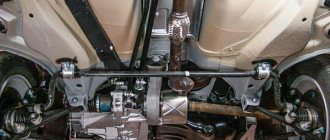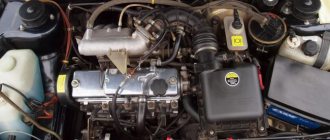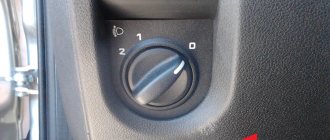The Lada Granta is a budget front-wheel drive car that was developed on the basis of the Lada Kalina. Sales of the car began at the end of December 2011. Currently, 5 types of engines are installed on Lada Granta/Kalina 2:
- VAZ-11183-50 (82 hp)
- VAZ-11186 (87 hp)
- VAZ-21126 (98 hp)
- VAZ-21127 (106 hp)
- VAZ 21126-77 (120 hp)
Despite this diversity, the volume of all engines is the same and is 1.6 liters.
16 valve engine
This is a more technically advanced brother of the 8-valve. In fact, it represents a deep modernization of the VAZ-21126 engine. The model received an intake receiver of variable length, due to which its power increased from 98 hp. up to 106 hp
Advantages of a 16-valve engine
If you tune the version with 16 valves, you can reduce the acceleration time of the car to 9 seconds. This is ideal for highways where speeds exceed 100 km/h. At these speeds, the 16-valve model feels more confident in handling.
The design of the internal combustion engine includes hydraulic compensators, which save the machine from zero maintenance with valve adjustment. There is a groove in the engine, so there is no need to be afraid that the valves will be bent.
Disadvantages of the 16-valve engine:
- cost - in some versions of the Lada Granta, the price difference between models with 8 and 16 valves is 100,000 rubles.
In terms of torque, the 16-valve version is inferior to the 8-valve version. To spin the engine to 148 N*m, you will need more than 4000 rpm.
Among the design flaws, it is worth mentioning the problem of spark plug wells sweating with a mileage of 10,000 km or more. Oil begins to drip inside. This is due to the use of sealant rather than gasket as a seal.
Add a comment Cancel reply
You must be logged in to post a comment.
On modern VAZ engines, when the timing belt breaks, the valves “meet” the piston, which causes critical damage and requires expensive repairs. In this regard, AvtoVAZ decided to modernize its line of engines by installing new pistons that will eliminate such damage, writes CARscope.ru, citing its sources.
The plant's supplier, Federal Mogul, has mastered the production of pistons with recesses (holes, counterbores) in the bottom. Motors with such pistons are popularly called “plug-free”, that is, when the timing belt breaks, the valves do not “plug” into the pistons, the bottoms of which have special grooves for this case.
The new piston group is designed for a range of 1.6-liter engines that are installed on the Lada Granta, Kalina, Largus, Vesta, XRAY models:
- VAZ-11186 (8 cells, 87 hp)
- VAZ-21126 (16 cells, 98 hp)
- VAZ-21127 (16 cells, 106 hp)
- VAZ-21129 (16 cells, 106 hp)
For the 1.8-liter engine with the VAZ-21179 index, a modified piston group is not provided.
Update 08/29/18
: The day before the opening of MIAS-2018, AvtoVAZ representatives presented the updated Lada Granta family to the media. Now, on all Granta engines - both 8-valve and 16-valve - they use “stickless” pistons, that is, with grooves where the valve “falls” if the timing belt breaks, and the piston pushed up by inertia will go to it towards. Nikita Gladky (product manager) told Kolesa.Ru about this.
Update 09/04/18
: The website Lada.online clarified the information in the official LADA group on VK. Answer:
To the question “both Vesta and XRAY with 1.6 liter?” They answered like this:
Later, AvtoVAZ customer service reported:
Lada Largus also received such an engine modification, because This car is equipped with similar 1.6-liter engines.
Update 09/06/18
: A slide titled “Engine piston design change” has leaked online. It states that new pistons are used for all engines (only 1.6-liter engines are shown in the photo). The holes in the bottom of the piston for the full stroke of the valves eliminate the possibility of sticking the valves into the piston if the timing kinematics are disrupted (for example, if the belt breaks).
A new coating and a change in the side profile of the piston skirt made it possible to increase the wear resistance of the pistons and, as a result, reduce the tendency of engines to knock and increase fuel consumption.
New 8-valve VAZ-11182
In 2022, AvtoVAZ introduced a new engine for the Lada Granta FL. This is AR16SEg2 or VAZ-11182. Its main feature is an increase in torque. At 1000 rpm, 80% of the torque is already available.
Design changes include:
- renewal of the connecting rod and piston group;
- modernization of the gas distribution mechanism;
- crankshaft modernization.
Advantages of VAZ-11182:
- reduced consumption;
- reduction in switching frequency;
- no need to adjust valves up to 90,000 km;
- groove;
- absence of oil drips due to six-bolt fastening of the oil cap and improved design of the silicone gasket;
- use of Renault spare parts;
- resource 180,000 km.
Disadvantages of the VAZ-11182:
- lack of hydraulic compensators;
- complicated valve clearance adjustment (at a mileage of 90,000 km);
- increased compression ratio, for better torque you will need to fill in AI-95;
- high cost of spare parts.
Technical characteristics of the VAZ-21126-77 engine
| VAZ-21126-77 | |
| Installed on cars: | Lada Granta Sport and Lada Kalina Sport |
| Years of production, year | since 2013 |
| Cylinder block material | cast iron |
| Supply system | injector |
| Type | in-line |
| Number of cylinders | 4 |
| Valves per cylinder | 4 |
| Compression ratio | 11 |
| Engine volume, l | 1,6 |
| Power | 120hp/5900rpm |
| Torque | 154Nm/4740rpm |
| Fuel consumption (city/highway/mix), l | -/-/7.8 per 100 km |
| Oil consumption | 50g/1000km |
| Engine oil quantity | 3.5l |
| Engine life (according to the passport/actually) | 200/200 thousand km. |
Let us remind you that in another article we determine the best VAZ engine for a modern Lada car.
Keywords: Lada Granta engine | Lada Kalina engine
0 0 0 0 0 0
Share on social networks:
Characteristics of power units
| Motor | 8-valveVAZ-11186 | 16-valve VAZ-21127 | 8-valve VAZ-11182 |
| Overclocking | 11.6 s. | 10.5 s. | – |
| Engine power | 87 hp | 106 hp | 90 hp |
| Torque | 3800 rpm 140 N*m | 4000 rpm 148 N*m | 3800 rpm 143 n*m |
| Volume | 1596 cm3 | ||
| Diameter of one cylinder | 82 mm | ||
| Piston stroke | 75.6 mm | ||
| Nutrition | injector | injector | distribution injection |
| Compression | 10.3-10.5 | 10.5-11 | 10.5 |
Lada Granta engines 8 valves
This power unit was installed only until December 2014, until it gave way to the 11186 internal combustion engine. This is an injection 8-valve engine with a single camshaft, a timing belt drive and without hydraulic compensators, so the thermal valve clearances here will have to be adjusted yourself. Thanks to special holes in the pistons, if the valve belt breaks, it will never bend.
There are plenty of problems with this engine; first of all, owners are bothered by all sorts of noises, knocks, and vibrations. Unreliable electrics, as well as a capricious thermostat, can throw you many unpleasant surprises. Due to poor fuel, valve burnout sometimes occurs here.
Similarly, the Motor VAZ website talks about all the details of the internal combustion engine design
This unit is an improved version of the previous one. There is already a lightweight piston with anti-friction inserts, a timing belt from Gates with a service life of 180 thousand km, an electronic throttle valve, a developed cooling jacket and many other improvements, thanks to which it was possible to fit this rather old engine into the strict EURO 4 econorms. Due to the new pistons without holes in the bottom, if the valve belt breaks, it almost always bends. Update: in mid-2022, the manufacturer equipped the unit with plugless pistons.
Reliability, weaknesses, maintainability
Reliability
According to the majority of car owners, the VAZ-21127 engine is reliable and, what is especially pleasing, economical to operate. The reliability of the motor is confirmed by many factors.
Firstly, a resource. The manufacturer stated 200 thousand km. But practice shows that in reality it easily reaches 300-350 thousand km and this is not the limit.
The only thing you need to know is that such a mileage is only possible with proper care of the engine. This concept includes timely maintenance, the use of high-quality fuels and lubricants, reducing the time required for regular maintenance, and careful operation of the internal combustion engine.
Secondly, a high safety margin. Despite the fact that during assembly the VAZ-21127 already received factory tuning, the possibility of increasing power remained. But you need to be extremely careful in this matter - additional tuning of the engine significantly reduces its service life.
The pursuit of “extra horsepower” will result in a major overhaul of the entire engine in the near future.
Thirdly, engine reliability is ensured by the presence of imported parts and components (fuel rail, timing belt, tensioner, idler pulley, connecting rod and piston group, etc.).
Piston and connecting rod from Federal Mogul
Fourthly, the reliability of the internal combustion engine has been increased by improving some components and parts in comparison with its predecessor. Thus, the exhaust tract, the ignition system, the use of a metal impeller in the water pump, the replacement of the mass air flow sensor and a number of other innovations have been changed.
Thus, the sufficient reliability of the VAZ-21127 is not a myth, but a reality.
Weak spots
Despite the improvements made to the base model, the VAZ-21127 is not without weaknesses. Among them there are those that appear due to the fault of car owners.
Engine tripping. Most often, this problem occurs due to clogged fuel injectors or faulty spark plugs. In the first case, it is enough to flush the fuel system; in the second, you will have to change the spark plugs.
When the engine fails, the main share of the blame lies with the car owner, since untimely maintenance and refueling with low-quality gasoline are what cause this malfunction. Timely replacement of spark plugs (after 15-20 thousand kilometers of a car) also eliminates this problem in the internal combustion engine.
The next weak point is the possibility of engine overheating. The author of this phenomenon is a faulty thermostat. Its timely replacement prevents overheating of the motor. In this case, all elements of the cooling system must be clean and in working condition, the coolant level is normal, and there are no leaks in the system.
Electrical malfunctions. Here, first of all, doubts about the performance are caused by the ECU, ignition coils and sensors. The true cause of failures can only be identified by diagnosing the engine at a specialized service station.
Timing belt Engines manufactured before July 2022 are of particular concern. Their problem was that the valves were bent when the timing belt broke. The manufacturer stated its resource is 180-200 thousand km, but you should not delude yourself with this.
The fact is that the belt can wear out, but the deflection pulley does not. At about 80 thousand km, the car jams. As a result, the drive belt breaks.
The condition of the timing belt must be monitored
Engines manufactured after this date do not have the problem of bent valves. This is facilitated by specially designed pistons.
Car owners often notice extraneous knocking noises in the engine. As a rule, this noise is created by hydraulic compensators. But knocking can also be caused by an extremely worn SHPG, or, less commonly, by burnt-out valves. In any case, when knocking occurs, the engine requires professional diagnostics.
Malfunctions detected and corrected in a timely manner postpone repairs for a long time.











